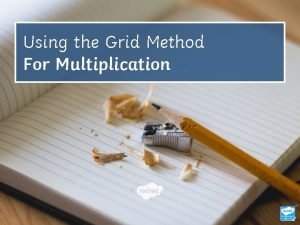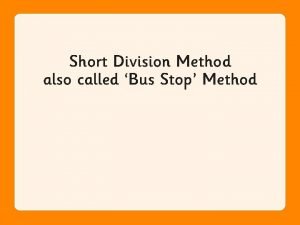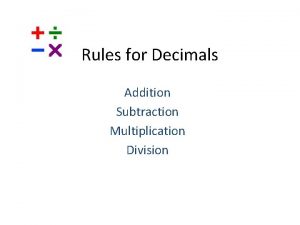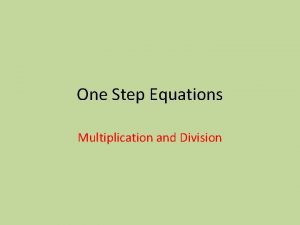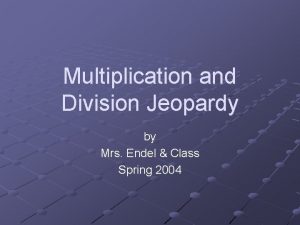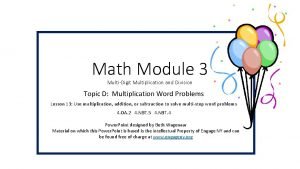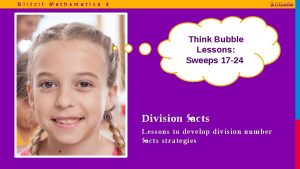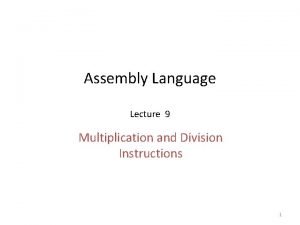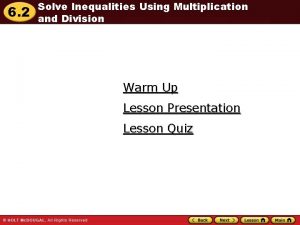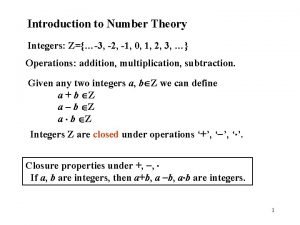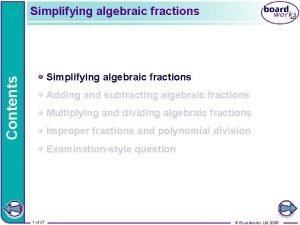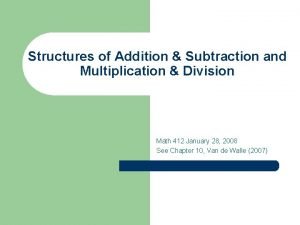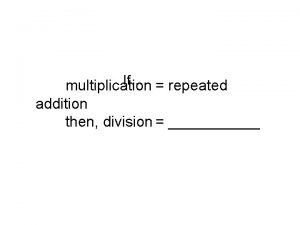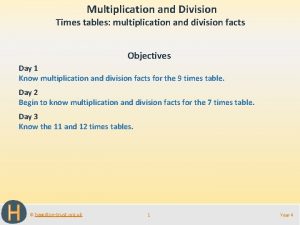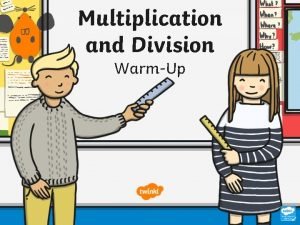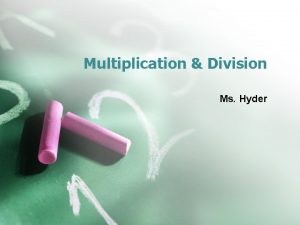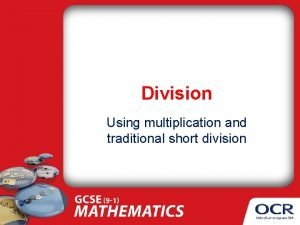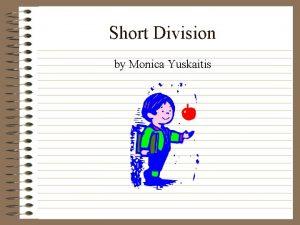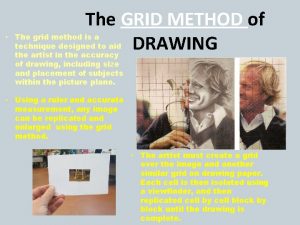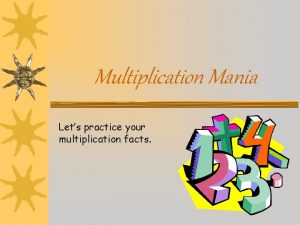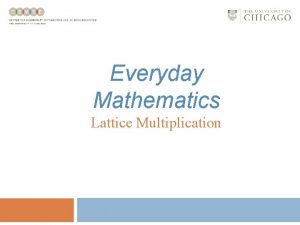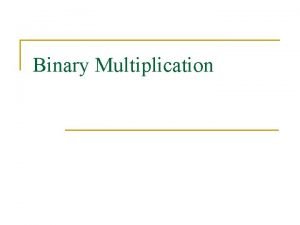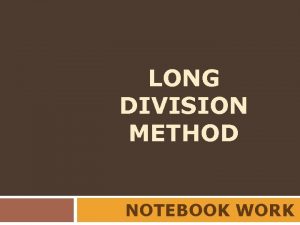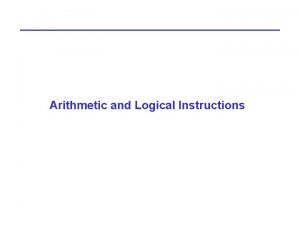Multiplication and division Grid method and short multiplication



























- Slides: 27

Multiplication and division Grid method and short multiplication Objectives Day 1 Revise using grid multiplication to multiply 3 -digit numbers by singledigit numbers. Day 2 Use short multiplication to multiply 3 -digit numbers by single-digit numbers. Day 3 Use short multiplication to multiply 3 -digit numbers by single-digit numbers. Day 4 Use short multiplication to multiply 3 -digit numbers by single-digit numbers including amounts of money. © hamilton-trust. org. uk 1 Year 5

Multiplication and division Grid method and short multiplication Starters Day 1 6, 60, 7 and 70 times tables (pre-requisite skills) Day 2 Times tables (pre-requisite skills) Day 3 Factors and multiples (simmering skills) Day 4 Find the time later using 24 -hour clock (simmering skills) Or Multiply by multiples of 10 (e. g. 24 x 30) (simmering skills) © hamilton-trust. org. uk 2 Year 5

Multiplication and division Grid method and short multiplication Starter 6, 60, 7 and 70 times tables © hamilton-trust. org. uk 3 Year 5

Multiplication and division Grid method and short multiplication Starter Times tables © hamilton-trust. org. uk 4 Year 5

Multiplication and division Grid method and short multiplication Starter Factors and multiples Click here NUMBER GENERATOR © hamilton-trust. org. uk 5 Year 5

Multiplication and division Grid method and short multiplication Starter Find the time later using 24 -hour clock Click here © hamilton-trust. org. uk 6 Year 5

Multiplication and division Grid method and short multiplication Starter Multiply by multiples of 10 (e. g. 24 x 30) © hamilton-trust. org. uk 7 Year 5

Multiplication and division Grid method and short multiplication Objectives Day 1 Revise using grid multiplication to multiply 3 -digit numbers by singledigit numbers. © hamilton-trust. org. uk 8 Year 5

Day 1: Revise using grid multiplication to multiply 3 -digit numbers by single-digit numbers. Discuss with your partner how you might work out 234 × 6. We could use the grid method… × 6 200 1200 × 8 What if it was 234 × 8? Work in pairs to use the grid method to find the answer. 30 180 200 1600 4 24 1404 30 240 4 32 1872 Now work out 276 × 6 and 358 × 7 © hamilton-trust. org. uk 9 Year 5

Day 1: Revise using grid multiplication to multiply 3 -digit numbers by single-digit numbers. Which of these do you think will have the biggest answer? Use rounding to estimate the answer to each. 8 x 376 8 x 400 = 3200 345 x 7 6 x 482 300 x 7 = 2100 6 x 500 = 3000 Will the exact answer be more or less than 3200? How do you know? Work out the exact answers to each. 410 × 9 400 x 9 = 3600 Did you need to use the grid method to work out the answer to this one? Compare the answers with your approximations. Note that our estimates are usually more ’out’ when multiplying than when adding or subtracting. © hamilton-trust. org. uk 10 Year 5

Day 1: Revise using grid multiplication to multiply 3 -digit numbers by single-digit numbers. Whole class investigation 6 6 5 7 • Use these cards to make a 3 -digit by single-digit multiplication. Try to make it so everyone in your group has a different multiplication. Compare your answers. • Which multiplication gave the biggest answer? Any surprises? Has anyone got an even bigger answer? • Work together to find the smallest possible answer and the largest possible answer. © hamilton-trust. org. uk 11 Year 5

© hamilton-trust. org. uk 12 Year 5

Multiplication and division Grid method and short multiplication Objectives Day 2 Use short multiplication to multiply 3 -digit numbers by single-digit numbers. © hamilton-trust. org. uk 13 Year 5

Day 2: Use short multiplication to multiply 3 -digit numbers by single-digit numbers. Use the grid method to work out the answer to 3 × 326. × 3 300 900 20 60 6 18 Today, we are going learn a new method of multiplication called short multiplication – it takes up less space than the grid method. Now we work out 3 × 20, 2 6 isplus 18. the We 1 write tens. 6 tens, Then we work out. That’s 3 3× times 300. 8 from in the 1 s column and tenand we the had multiplying That’s nine 100 s we write the 17 ten in the 10 s 1 s, column. so that's tens, so we this in thethe 100 s above the line like write 7 column in the 10 s column. we do for addition. 978 Where We added And the 900? is 60? Where is 18 in the short the 10 at themultiplication same time! method? © hamilton-trust. org. uk 3 2 6 x 3 1 9 78 14 Year 5

Day 2: Use short multiplication to multiply 3 -digit numbers by single-digit numbers. Now let’s use short multiplication to work Now we work outout 3 × 60. 31 x 3 hundred 263. Then we work out × 200. and 8 tens. That’s six 100 s. We add We write the 1 hundred in the one 100 we made fromabove the line, 100 s column times 3 addition, is 9. Weand multiplying the write like 10 s, we 3 and do for in the 7 in the 100 s thecolumn. 8 write in thethe 10 s 9 column. 1 s column. Use the grid method to work out 3 x 263. x 3 200 60 180 3 9 2 6 3 x 3 1 78 9 789 Work individually to use short multiplication to work out 4 × 217 and 5 × 261. © hamilton-trust. org. uk Choose one and explain how you worked it out to a partner. 15 Year 5

© hamilton-trust. org. uk 16 Year 5

Multiplication and division Grid method and short multiplication Objectives Day 3 Use short multiplication to multiply 3 -digit numbers by single-digit numbers. © hamilton-trust. org. uk 17 Year 5

Day 3: Use short multiplication to multiply 3 -digit numbers by single-digit numbers. How many meals do you think you might eat in a year? ! In most years there are 365 days and we mostly eat 3 meals a day. Let’s use short multiplication to work out the answer. Some children are going to use the grid method to work out 3 × 365. Now we work out 3 × 60. That’s 1 Then we work out 3 × 300. 3 times is 15. plus Wethe write hundred and 85 tens, 1 ten That’s nine 100 s, plus the 1 the 5 in the 1 s 1 s. column and the from multiplying the We write hundred from multiplying the 1 inten the 10 s column 1 hundred thein 100 s column above 10 s. That’s ten 100 s, 1000. the line, and above the 9 inthe theline. 10 s column. 3 6 5 x 3 1 1 10 9 5 © hamilton-trust. org. uk × 3 300 900 60 180 5 15 1095 We get the same answer! 18 Year 5

Day 3: Use short multiplication to multiply 3 -digit numbers by single-digit numbers. How many drinks do you think you might have in a year? Work out the answer using short multiplication or grid method. Work in pairs to work out how roughly how many meals you might have eaten in your life or how many drinks you have had. © hamilton-trust. org. uk Be ready to share your answer, and how you reached it. 19 Year 5

© hamilton-trust. org. uk 20 Year 5

Multiplication and division Grid method and short multiplication Objectives Day 4 Use short multiplication to multiply 3 -digit numbers by single-digit numbers including amounts of money, e. g. 3 × £ 4. 56. © hamilton-trust. org. uk 21 Year 5

Day 4: Use short multiplication to multiply 3 -digit numbers by single-digit numbers including money. We could use the grid method or jottings to record steps. What do you think the answer is approximately? 6 × £ 5. 24. How could we work this out? Talk to your partner. Six lots of £ 5 is £ 30, so the answer will be a bit more than that. We write £ and p by each product to be clear. × £ 5 6 £ 30 20 p 4 p £ 1. 20 24 p £ 31. 44 Add the pounds, and then the pence. As six lots of 20 p is greater than £ 1, we need to be careful how we record this, so that we add the products correctly. © hamilton-trust. org. uk £ 5. 2 4 × 6 1 2 £ 3 1. 4 4 6 x 20 p + 20 p = £ 1. 40 22 Year 5

Day 4: Use short multiplication to multiply 3 -digit numbers by single-digit numbers including money. Use the grid method to start working out £ 5. 45 × 7. The addition is a bit more tricky this time. If you find the addition difficult to do mentally, turn the grid round so you can use column addition to help. . . × £ 5 7 £ 35 x £ 5 40 p 5 p £ 2. 80 35 p Now find the cost of 8 items at £ 6. 79 each, choosing either the grid method or short multiplication. © hamilton-trust. org. uk 23 7 £ 35 £ 2. 80 35 p 1 £ 38. 15 Year 5

Challenge © hamilton-trust. org. uk 24 Year 5

Multiplication and division Grid method and short multiplication Well Done! You’ve completed this unit. Objectives Day 1 Revise using grid multiplication to multiply 3 -digit numbers by singledigit numbers. Day 2 Use short multiplication to multiply 3 -digit numbers by single-digit numbers. Day 3 Use short multiplication to multiply 3 -digit numbers by single-digit numbers. Day 4 Use short multiplication to multiply 3 -digit numbers by single-digit numbers including amounts of money. © hamilton-trust. org. uk 25 Year 5

Multiplication and Division Problem solving and reasoning questions Find the product of 274 and 6 using two different methods. Do your answers agree? Explain how you can work out 235 x 4 mentally. Now check your answer using short multiplication. Fill in the missing digits: 84☐ x ☐ ☐☐ 05 Write a multiplication of one 3 -digit number by 6 where the last two digits of the product are consecutive (e. g. 5, 6). © hamilton-trust. org. uk 26 Year 5

Problem solving and reasoning questions Find the product of 274 and 6 using two different methods. Do your answers agree? 1644 The two methods are grid and short multiplication. Where children have found 2 different answers can they identify their error? With the grid method these are often with place value or with the final addition, with short multiplication the layout needs to be clear. In both methods mistakes may simply be due to insecure recall of times table facts. Explain how you can work out 235 x 4 mentally. Now check your answer using short multiplication. 940. This can be found mentally by doubling twice. Fill in the missing digits: Write a multiplication of one 3 -digit number by 6 where the last two digits of the product are consecutive (e. g. 5, 6). The following are all the solutions where the answer is less than 1000, they can be found by consecutively adding 6 to 600: 102 x 6 = 612 109 x 6 = 654 126 x 6 = 756 133 x 6 = 798 152 x 6 = 912 159 x 6 = 954 © hamilton-trust. org. uk 113 x 6 = 678 122 x 6 = 732 139 x 6 = 834 146 x 6 = 876 153 x 6 = 978 27 Year 5
 Tall + short h
Tall + short h 369 times 2
369 times 2 Repeated subtraction method
Repeated subtraction method Grid method of multiplication
Grid method of multiplication Bus stop method with remainders
Bus stop method with remainders Lga vs pga
Lga vs pga Staar multiplication grid
Staar multiplication grid Adding decimal rules
Adding decimal rules One-step multiplication & division equations
One-step multiplication & division equations Multiplication and division properties
Multiplication and division properties Multiplication and division jeopardy
Multiplication and division jeopardy 13773x.to
13773x.to Solve multiplication and division equations
Solve multiplication and division equations Year 4 multiplication and division
Year 4 multiplication and division Percentage uncertainty
Percentage uncertainty Multiplying and dividing scientific notation worksheet
Multiplying and dividing scientific notation worksheet Multiplication facts and division facts
Multiplication facts and division facts Div in assembly
Div in assembly How to solve inequalities using multiplication and division
How to solve inequalities using multiplication and division Integers multiplication and division
Integers multiplication and division Complex algebraic fractions
Complex algebraic fractions Order of operations jeopardy
Order of operations jeopardy Solving multiplication and division equations
Solving multiplication and division equations How to use synthetic division
How to use synthetic division Synthetic division of polynomials
Synthetic division of polynomials Maths addition subtraction multiplication division
Maths addition subtraction multiplication division If multiplication is repeated addition what is division
If multiplication is repeated addition what is division Arithmetic addition subtraction multiplication division
Arithmetic addition subtraction multiplication division



